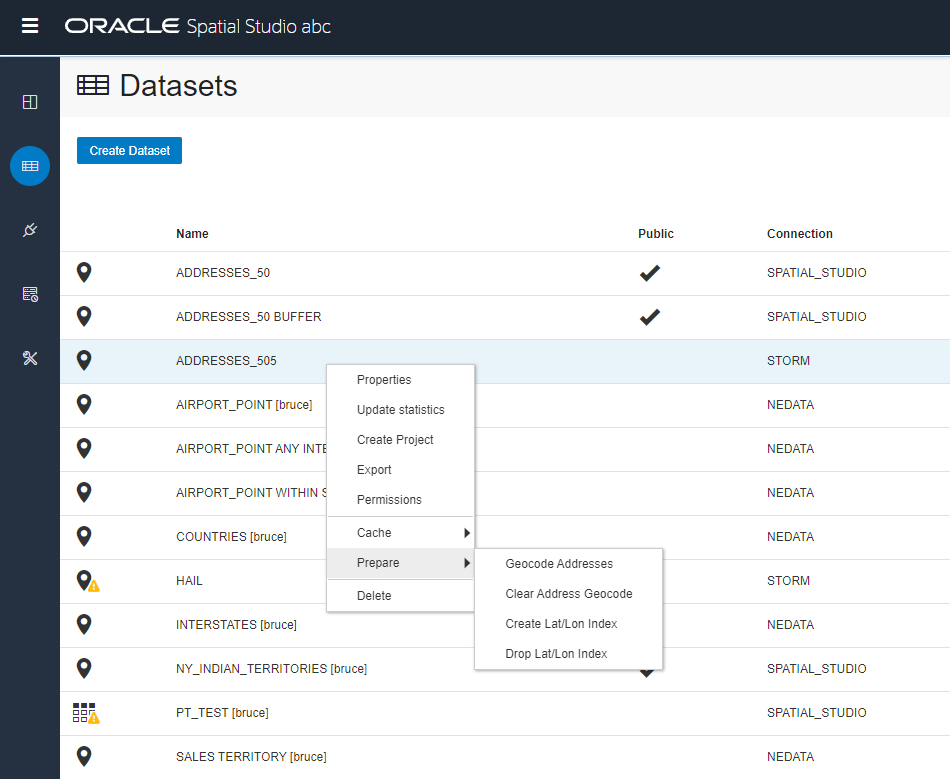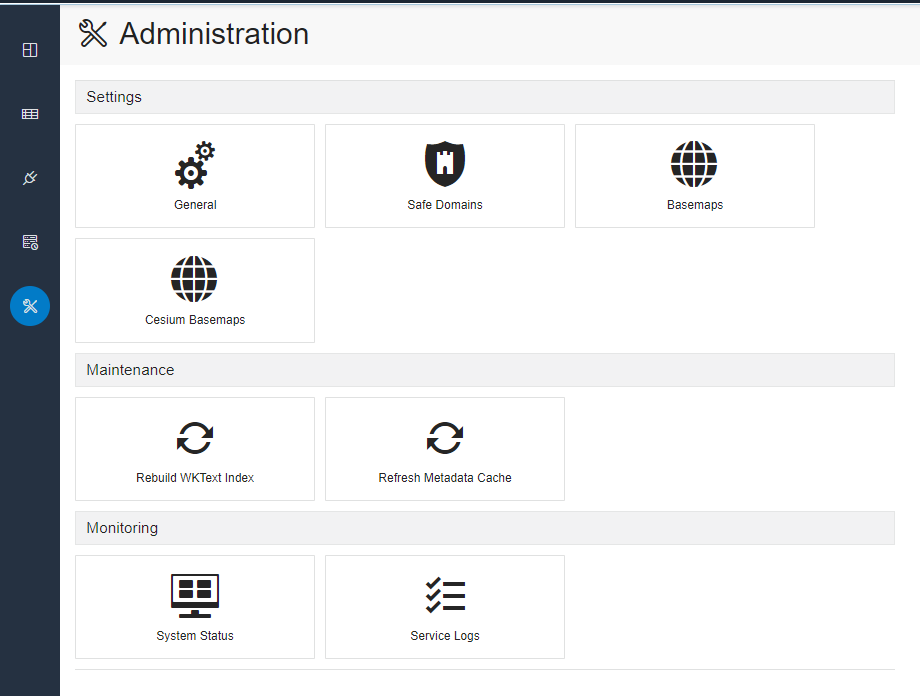3 Using Oracle Spatial Studio
As a user, you can create one or more projects, each of which can define one or more spatial datasets on which to perform various spatial operations.
- A project contains Spatial Studio objects, such as datasets, that are logically related to some intended usage. For example, a project might be named New England Sales Territories, or Sales Territories and Customers, or Ohio Airports and Counties. When creating a project, you should know the purposes for which you want to identify and analyze spatial data in a geographic area.
- A dataset is a collection of spatial features of a specific usage type and geometry type. For example, datasets might include Airports represented by polygon geometries, or Roadways represented by LRS line string geometries, or Accidents represented by point geometries.
- A connection specifies information for connecting to an Oracle Database schema where spatial data of interest resides: user name, password, system, port, database name, and so on. (It is similar to a SQL Developer connection)
(Be sure that you understand these terms and others that are defined in Spatial Studio Terminology.)
The project, dataset, and the connection page each contain a Create button that allows you to create the corresponding type of Studio object.
Spatial Studio has an initial (main) page that provides an overview of the tool and links to tutorial resources, and several pages devoted to major user operations. The following figure shows the main page, with the navigation drawer expanded to show the left side menu of major objects that you can work on.
Navigation Drawer ("hamburger" icon, upper left):
- Projects (initially selected): Includes any existing Projects and Published Projects.
- Dataset: This page lists all the existing datasets available to the current user.
- Connections: This page lists all the existing connections (data sources) available to the current user.
- Console: Lets you monitor the status and activity of Spatial Studio, with tabs for Settings, System Status, and About.
- Tasks: Tabs for various "tasks" (background jobs started by Spatial Studio to implement user requests)
- Getting Started Using Spatial Studio
Spatial Studio includes a page with information and links to help you get started using the tool. - Spatial Studio Projects Page and Active Project
The Projects page lists all projects that have been created, both unpublished and published. - Spatial Studio Data Page
The Data page lets you view and edit existing datasets, and create new ones. - Spatial Studio Console
The console lets you monitor the status and activity of Spatial Studio. You can view server logs, change global system configurations, manage custom basemaps, and white list the safe domains. - If the Spatial Studio Repository Schema Password Has Been Changed
3.1 Getting Started Using Spatial Studio
Spatial Studio includes a page with information and links to help you get started using the tool.
To display this page, click the small question mark icon (?) in the top right area of most pages (above the Create button). The Get Started with Spatial Studio page includes:
- Watch Overview: Watching this video is perhaps the best way to grasp the user interface and see how to perform available actions.
- Prepare Data: Enable your business data for mapping and spatial analytics.
- Visualize and Analyze: Explore geographic patterns and relationships in your business data.
- Learn More: Visit our video library to learn more about Oracle Spatial Cloud.
Parent topic: Using Oracle Spatial Studio
3.2 Spatial Studio Projects Page and Active Project
The Projects page lists all projects that have been created, both unpublished and published.
To work on or see details about a project, click its icon, which makes it the Active Project. Starting Oracle Spatial Studio release 20.1, you no longer have a separate Active Project page. When you click and open an existing project page, it replaces the project list page.
Layers List - Data: For a selected active project, shows lists of datasets added. Right-click any Data item to see this context menu including: Spatial Analysis, Zoom to Layer, Cut, Paste Before, Paste After, Delete, Symbol Style, Heatmap Style, Properties.
To see data layer-related options, click the menu selector next to the layer name to display available options:
- Settings: Shows display options for Style, Interaction, and Legend.
- Spatial Options: Lets you perform many spatial operations (All, or filtered by type: Filter, Combine, Transform, Measure), such as Add a buffer of a specified distance, Return shapes having spatial relationship to another, and Calculate area.
- Zoom to Layer: Zooms the display (out or in) to fit the entire layer.
- Refresh Layer: Refreshes the layer to reflect all user actions.
- Remove: Removes the layer from the project.
In the top right area of the Active Project display are icons for Save, Save As, Share (for publishing), Project Settings (Name, Created By, Description), and Close the active project:
Parent topic: Using Oracle Spatial Studio
3.3 Spatial Studio Data Page
The Data page lets you view and edit existing datasets, and create new ones.
The following figure shows the Data page:
Figure 3-5 Data Page, Including Dropdown Menus

Description of "Figure 3-5 Data Page, Including Dropdown Menus"
To create a new dataset, click Create Dataset. You can create a dataset from a:
- Spreadsheet file
- Shapefile
- GeoJSON file
- Connection
- 3D Tiles tileset files
For any dataset in the display, you can click the down-arrow after Last Modified Date and select from the following:
- Properties: View or modify properties of the dataset.
- Create Project: Create a new project.
- Delete Dataset: Delete this dataset.
- Export Dataset: Export this dataset (GeoJSON or CSV file format).
- Prepare (Addresses, Clear enrichment, Create Lon/Lat index, Drop Lon/Lat Index)
Parent topic: Using Oracle Spatial Studio
3.4 Spatial Studio Console
The console lets you monitor the status and activity of Spatial Studio. You can view server logs, change global system configurations, manage custom basemaps, and white list the safe domains.
Note:
You must be logged in as an administrator of Spatial Studio.Settings
- General: This section allows changing the GeoCoding service URL, the web proxy used by the Studio server. It also allows you to customize the frontend branding area of the application.
- Safe Domains: This section allows the administrator to manage the white listing of the domains (host names or IP addresses) that are considered safe for loading various types of the resources from the Studio application. Typically, it is used to add the domain of a custom basemap to the Content Security Policy directives of the Studio. After making the changes to the safe domains list, you must reload or refresh the browser page to reload the new Content Security Policy.
- Basemaps: This section allows a quick view of the existing custom basemaps, and in adding new custom basemaps. Custom basemaps can be made of either raster or vector tiles, typically hosted on a third party tile server.
- Cesium Basemaps: This section gives you a quick view of the existing custom basemaps used exclusively for the 3D Cesium Map visualization. It also allows you to add new basemaps to be used by the 3D Map visualizations.
Maintenance
- Rebuild WKText Index: This section is used only when you need to rebuild the text index of the repository database schema’s supported Spatial Reference Well Known text definitions. For the shapefile upload, this well known text index is used to automatically match the best SRID.
- Refresh Metadata Cache: Spatial Studio typically caches all of the frequently used metadata such as the definitions of Datasets, Connections, and Projects. Sometimes it is required to refresh the whole cache in case some cached metadata becomes stale or out of sync in rare events.
Monitoring
- System Status: This section provides read-only information about the general health and system status of the Spatial Studio server. In a cluster deployment, this section displays only the information of the particular Studio instance to which the current session is connected.
- Service Logs: This section allos you to load and view a desired number of server-side logs. To reduce the clutter, you can filter the result using the desired logging level .
Parent topic: Using Oracle Spatial Studio
3.5 If the Spatial Studio Repository Schema Password Has Been Changed
It the Spatial Studio Repository Schema Password has been changed, you must update
the sgtech_config.json configuration file, as follows:
- Make a backup copy of the file. For example, copy
~/.sgtech/sgtech_config.jsonto~/.sgtech/sgtech_config.json_backup. - On the Spatial Studio compute node, edit the file
~/.sgtech/sgtech_config.json. - In the metadata_schema section, update
database_passwordto the desired value. - Save the file and then restart the Spatial Studio deployment. To restart if you are using the Quick Start kit, see the see the README file for the Quick Start; to restart if this is a WebLogic Server deployment, use the WebLogic Server console.
- Open the Studio Spatial Studio application. You should be able to log in.
You will still have all the artifacts you had created, including other (non-repository) connections, which you can edit as needed.
Parent topic: Using Oracle Spatial Studio



